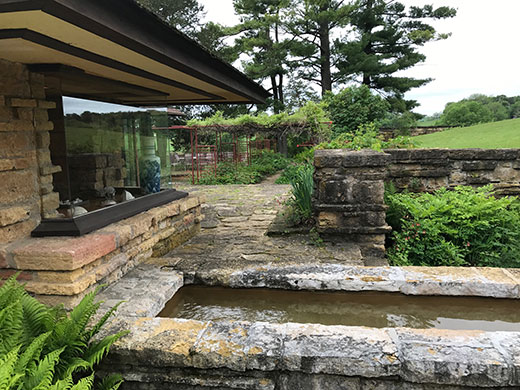It’s the 150th anniversary year of Frank Lloyd Wright’s birth, an apt time to revisit the architect’s larger than life image and his fabled school less than three hours from Peoria. The architect left us with much to consider – not just about building, but geography and identity. Recognized as a super-entrepreneur who worked into his early 90s, he was a risk-taker and one of the most complicated of our public intellectuals. Wright’s practice and ideology were radical and tethered to the populism of the American Midwest. He was an iconoclast, critic and neo-collectivist and insisted that architects be fearless cultural leaders. The full dimension of Wright is less known to the public now, even though he affected American culture as much as any of our bread and butter American heroes. He is rarely extolled in the mainstream of American education, nor for that matter is any modern architect. Yet our national identity might offhandedly be summarized as democracy, capitalism, modernism, and Frank Lloyd Wright.

PHOTO BY PAUL KRAINAK
Taliesin Garden Court, Spring Green, Wis.
Wright educated himself. He disrespected the country’s school system, which he thought uncreative and uncritical. He despised the neo-classical design of his period. Instead he looked to Mesoamerican and Asian architecture for inspiration. He loathed what our American cities had become, calling them bastions for bankers and prostitutes and believed that the United States was an experiment in danger of losing its Jeffersonian ideals. He showed us – told us really – how we should combine revolutionary design with ordinary, inexpensive materials milled from and formally re-integrated into the landscape. Nature was his only religion.
Wright’s principal contribution, and one most significant to Midwesterners, was his founding of an American architecture. For him building should neither be a convention nor an abstraction. He proposed fundamental changes for rural and urban dwellings that impacted both our personal and working lives. He would neither conform to a classical order rooted in European history nor look to its International Style as the only kind of progress. He discovered his method in the American prairie, like the bucolic, industrious farm of his Wisconsin childhood.
Wright fostered a deep respect for art and music, in fact demanded it from his students and clients. He made buildings that were artworks pure and simple by hybridizing handmade objects with prefabricated forms. All the chestnuts about how his architecture was transformative for those who lived and worked in them, that they were a roadmap for future built environments, is no exaggeration. He was exemplary of what the Midwest demands of artists and intellectuals – an allegiance to more than one stratum of society, profession or kind of intelligence. He was confident that history would validate his naturalist vision as he was devoted to craft and engineering over style. His drawings are some of the most imaginative and beautiful in the history of Western art.
Wright’s work reflects a life of contemplation, something still germane in the Midwest and a critical condition of modern art. His architecture was not merely an affirmation of change. It advanced a critical, sited narrative rather than today’s hollow spectacle of globalism whose bi-product is cultural amnesia. Taliesin, Wright’s farm, studio and school of architecture is maintained by the Wright Preservation and Foundation and is an incomparable cultural destination. Its 800 acres are on the tentative list of UNESCO’s World Heritage Sites. Indebted to the 19th century Arts & Crafts movement, Wright’s oeuvre is also part of a legacy of Midwestern designers who respected their clients enough to make advanced engineering and organic designs functional, affordable, pleasurable and enduring.

Recent Comments